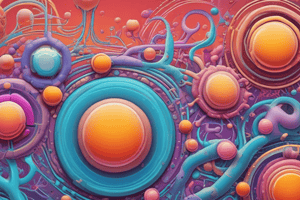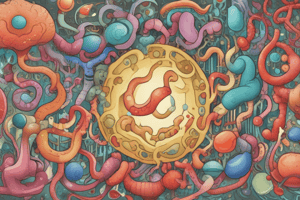Podcast
Questions and Answers
Chylomicrons transport cholesterol from the intestine to the rest of the body.
Chylomicrons transport cholesterol from the intestine to the rest of the body.
False (B)
Liver cells recognize and remove remnants of chylomicrons from the blood.
Liver cells recognize and remove remnants of chylomicrons from the blood.
True (A)
Cells remove triglycerides from chylomicrons as they pass by, causing the chylomicrons to increase in size.
Cells remove triglycerides from chylomicrons as they pass by, causing the chylomicrons to increase in size.
False (B)
VLDL is primarily made in the intestines rather than the liver.
VLDL is primarily made in the intestines rather than the liver.
As VLDL travel through the body, cells remove cholesterol, causing VLDL to shrink.
As VLDL travel through the body, cells remove cholesterol, causing VLDL to shrink.
Low Density Lipoproteins (LDL) contain high amounts of triglycerides.
Low Density Lipoproteins (LDL) contain high amounts of triglycerides.
LDL circulate throughout the body, making their contents available only to the cells of fat stores and muscles.
LDL circulate throughout the body, making their contents available only to the cells of fat stores and muscles.
Special HDL receptors on liver cells play a crucial role in the transportation of lipids.
Special HDL receptors on liver cells play a crucial role in the transportation of lipids.
High LDL cholesterol is linked to a high risk of heart attack.
High LDL cholesterol is linked to a high risk of heart attack.
HDL have pro-inflammatory properties that lead to atherosclerosis.
HDL have pro-inflammatory properties that lead to atherosclerosis.
Physical activity is a factor that can lower LDL cholesterol or raise HDL cholesterol.
Physical activity is a factor that can lower LDL cholesterol or raise HDL cholesterol.
Weigh control has no impact on cholesterol levels in the body.
Weigh control has no impact on cholesterol levels in the body.
Flashcards are hidden until you start studying




